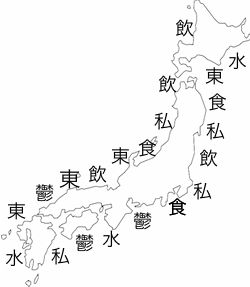So, how do you learn over 2000 complex Chinese characters with multiple pronunciations each? Anywhere he wants to! Er, wait, wrong joke. Bird by bird! That’s it.
Some Japanese learners are lucky enough to arrive with kanji in their pockets because they grew up speaking (and reading and writing) Chinese. There are a few Chinese students in my community college class, and I sure am envious.
For the rest of us, there are a bunch of competing kanji-learning approaches, but we can boil it down to (1) Remembering the Kanji and (2) everything else.
In my class, for example, we are learning kanji in a watered-down version of the way Japanese kids learn it: beginning with the most common kanji, our sensei puts a character on the board and shows us how to write it and how it’s used in a few words we know, and then we practice writing it our workbook. Next week we have a quiz on the kanji we’ve learned so far, which include 大 (big), å›› (four), and 月 (month).
What’s wrong with this approach? Nothing, if you want to learn a few kanji. What if you want to learn all the kanji? Then you will meet up with James Heisig and his book Remembering the Kanji, or RTK for short.
The conceit of RTK is that you should learn how to write and recognize the kanji before you learn how to pronounce them or combine them in words. Doing it all at once is too hard. From the perspective of the English alphabet, this is insane. The difference between the alphabet and kanji, however, is that kanji has a hundred times has many characters, and most characters are made up of miniature versions of other characters.
So if you want to remember the Kanji, says Heisig, you don’t start with the most common characters. You start with a few basic shapes and build with them. So you end up learning some uncommon kanji before more common ones. (For example, the kanji for an obscure volume measurement comes several chapters before the kanji for “person.”) Heisig assigns each kanji a keyword so you sort of know what it means, but the keyword is more about keeping track of all your new friends, not about communication per se. After you learn all 2000+ official kanji, then you can start thinking about plebeian concerns like pronunciation, and words, and meanings.
How do you actually remember the kanji? With stories. If a kanji is made of multiple elements, you combine those elements into a little story, as memorable as possible. Heisig feeds you stories for a while and then steps aside to let you concoct your own. Someone also cooked up a brilliant free website to go with the book, where you can test yourself with flashcards and borrow stories from other learners. My favorite so far: the kanji for “bullseye” is made up of “white + ladle.” So you imagine white bird shit plopping–bullseye!–into your ladle just as you’re serving up some soup. I have no trouble remembering this character:
çš„
You can download the first 100+ pages of RTK free. I recommend it, even if you have no interest in kanji, for…well, for sadistic reasons.
RTK, you see, is notorious for turning its students into cultish dickheads. As in, “I learned 300 kanji today. What did YOU accomplish?” I plead absolutely guilty to this, and if RTK adherents sound like jingoistic frat boys, it’s because kanji itself is something of a hazing ritual. Why do frustrated college administrations find it impossible to stamp out fraternity hazing? Because nothing produces loyalty to the group better than shared adversity. Even though I’m only toes-deep in kanji, I can already tell that when I’m finished, I’ll feel about it the same way I do after I learned calculus or learned to navigate Greenwich village without a map: everyone should have to go through this!
Luckily for my family, I am reaching my kanji capacity. The first few dozen kanji are quite easy, and you can feel your brain craning open to let you shovel in knowledge. Then, suddenly, you’re trying to cram new toys into an already overfull toy box. I learned two new kanji today. What did you accomplish?
That said, Iris and I had a semi-amazing kanji breakthrough today on the way to lunch. Every Saturday we get a plate of dumplings at a restaurant called Sichuanese Cuisine. Today we noticed that the sign has three kanji on it, and two of them looked like this:
å››å·
We knew what that meant: four rivers! Then, hey, wait a second. “Four” in Japanese is “shi.” I wonder if it’s “si” in Chinese. Does “si chuan” mean “four rivers”?
P.S.: If you do speak Chinese, please forgive me for referring to hanzi as kanji. Everyone else, forget I said that.


